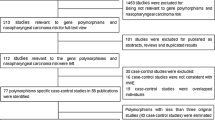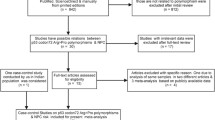Abstract
Data on the association between −1607 1G > 2G polymorphism in the promoter region of matrix metalloproteinase-1 (MMP1) and nasopharyngeal carcinoma (NPC) are conflicting. The aim of this study was to confirm whether this polymorphism was a causative factor of NPC. We searched PubMed, Embase, and China National Knowledge Infrastructure (CNKI) for studies on the present topic. A total of four publications (1,044 NPC patients and 1,284 healthy control subjects) were included and meta-analysis was performed to assess the association between −1607 1G > 2G polymorphism and NPC risk. Odds ratio (OR) with 95 % confidence interval (95 % CI) was calculated for 1G1G versus 2G2G, 1G1G + 1G2G versus 2G2G, 1G1G versus 1G2G + 2G2G, 1G versus 2G, and 1G2G versus 2G2G contrast models. Meta-analysis results showed significantly reduced risk of NPC associated with the 1G1G versus 2G2G, 1G versus 2G and 1G2G versus 2G2G contrast models (OR = 0.61, 95 % CI 0.49–0.77; OR = 0.78, 95 % CI 0.65–0.92; OR = 0.86, 95 % CI 0.74–0.99, respectively). When we continued to perform subgroup analysis by ethnicity, the significant association persisted in Asian population and was most pronounced under the 1G2G versus 2G2G model (OR = 0.85, 95 % CI 0.73–0.99). These data suggested that MMP1 −1607 1G > 2G polymorphism was associated with reduced risk of NPC, particularly in the population of Asian descent.



Similar content being viewed by others
References
Parkin, D. M., Whelan, S., Ferlay, J., Teppo, L., Thomas, D. B., et al. (2002). Cancer incidence in five continents, IARC Scientific Publications No. 155 (Vol. III). Lyon: IARC.
Cao, S. M., Simons, M. J., & Qian, C. N. (2011). The prevalence and prevention of nasopharyngeal carcinoma in China. Chinese Journal Of Cancer, 30(2), 114–119.
Chang, E. T., & Adami, H. O. (2006). The enigmatic epidemiology of nasopharyngeal carcinoma. Cancer Epidemiology Biomarkers & Prevention, 15(10), 1765–1777.
Jung, P. F. (1965). Familial tendency of nasopharyngeal carcinoma; a report of cases. Pacific Medicine and Surgery, 73, 242–243.
Ko, J. Y., et al. (1998). Familial clustering of nasopharyngeal carcinoma. Otolaryngology-Head and Neck Surgery, 118(5), 736–737.
Zhang, F., & Zhang, J. (1999). Clinical hereditary characteristics in nasopharyngeal carcinoma through Ye-Liang’s family cluster. Chinese Medical Journal, 112(2), 185–187.
Egeblad, M., & Werb, Z. (2002). New functions for the matrix metalloproteinases in cancer progression. Nature Reviews Cancer, 2(3), 161–174.
Stetler-Stevenson, W. G., Liotta, L. A., & Kleiner, D. E, Jr. (1993). Extracellular matrix 6: role of matrix metalloproteinases in tumor invasion and metastasis. FASEB Journal, 7(15), 1434–1441.
Liotta, L. A., DeVita, V. T., Helman, S., and Rosenberg, S. A., (Eds.). (1989) Cancer: Principles and Practice of Oncology (Vol I, pp 98–115). New York: J.B. Lippincott.
Fink, K., & Boratynski, J. (2012). The role of metalloproteinases in modification of extracellular matrix in invasive tumor growth, metastasis and angiogenesis. Postepy Higieny I Medycyny Doswiadczalnej (Online), 66, 609–628.
Tahara, K., et al. (2010). Serum matrix-metalloproteinase-1 is a bona fide prognostic marker for colorectal cancer. Annals of Surgical Oncology, 17(12), 3362–3369.
Pradhan-Palikhe, P., et al. (2010). Plasma level of tissue inhibitor of matrix metalloproteinase-1 but not that of matrix metalloproteinase-8 predicts survival in head and neck squamous cell cancer. Oral Oncology, 46(7), 514–518.
Li, M., et al. (2010). Prognostic significance of matrix metalloproteinase-1 levels in peripheral plasma and tumour tissues of lung cancer patients. Lung Cancer, 69(3), 341–347.
Rutter, J. L., et al. (1998). A single nucleotide polymorphism in the matrix metalloproteinase-1 promoter creates an Ets binding site and augments transcription. Cancer Research, 58(23), 5321–5325.
Hinoda, Y., et al. (2002). Association of functional polymorphisms of matrix metalloproteinase (MMP)-1 and MMP-3 genes with colorectal cancer. International Journal of Cancer, 102(5), 526–529.
Su, L., et al. (2006). Genotypes and haplotypes of matrix metalloproteinase 1, 3 and 12 genes and the risk of lung cancer. Carcinogenesis, 27(5), 1024–1029.
Nishizawa, R., et al. (2007). The 2G allele of promoter region of matrix metalloproteinase-1 as an essential pre-condition for the early onset of oral squamous cell carcinoma. BMC Cancer, 7, 187.
Nasr, H. B., et al. (2007). Matrix metalloproteinase-1 (−1607) 1G/2G and −9 (−1562) C/T promoter polymorphisms: susceptibility and prognostic implications in nasopharyngeal carcinomas. Clinica Chimica Acta, 384(1–2), 57–63.
Zhou, G., et al. (2007). Functional polymorphisms and haplotypes in the promoter of the MMP2 gene are associated with risk of nasopharyngeal carcinoma. Human Mutation, 28(11), 1091–1097.
Lau, J., Ioannidis, J. P., & Schmid, C. H. (1997). Quantitative synthesis in systematic reviews. Annals of Internal Medicine, 127(9), 820–826.
Higgins, J. P., et al. (2003). Measuring inconsistency in meta-analyses. BMJ, 327(7414), 557–560.
Mantel, N., & Haenszel, W. (1959). Statistical aspects of the analysis of data from retrospective studies of disease. Journal of the National Cancer Institute, 22(4), 719–748.
DerSimonian, R., & Laird, N. (1986). Meta-analysis in clinical trials. Controlled Clinical Trials, 7(3), 177–188.
Egger, M., et al. (1997). Bias in meta-analysis detected by a simple, graphical test. BMJ, 315(7109), 629–634.
Kondo, S., et al. (2005). Epstein-Barr virus latent membrane protein 1 induces the matrix metalloproteinase-1 promoter via an Ets binding site formed by a single nucleotide polymorphism: enhanced susceptibility to nasopharyngeal carcinoma. International Journal of Cancer, 115(3), 368–376.
Gao, W., Sui, J., Wang, B., Li, X., Zhang, C., Wen, S., et al. (2010). MMP-1(-1607)1G/2G gene polymorphism and susceptibility to nasopharyngeal carcinoma in Han population in Yunnan China. Chinese Archives of Otolaryngology-Head and Neck Surgery, 17(3), 116–120.
Gallicchio, L., et al. (2006). Adulthood consumption of preserved and nonpreserved vegetables and the risk of nasopharyngeal carcinoma: a systematic review. International Journal of Cancer, 119(5), 1125–1135.
Zhou, B., et al. (2009). A functional insertion/deletion polymorphism in the promoter region of NFKB1 gene increases susceptibility for nasopharyngeal carcinoma. Cancer Letters, 275(1), 72–76.
Nong, L. G., et al. (2009). Interleukin-18 gene promoter polymorphism and the risk of nasopharyngeal carcinoma in a Chinese population. DNA and Cell Biology, 28(10), 507–513.
Deng, L., et al. (2002). Cyclin D1 polymorphism and the susceptibility to NPC using DHPLC. Sheng Wu Hua Xue Yu Sheng Wu Wu Li Xue Bao (Shanghai), 34(1), 16–20.
Jalbout, M., et al. (2003). Polymorphism of the stress protein HSP70-2 gene is associated with the susceptibility to the nasopharyngeal carcinoma. Cancer Letters, 193(1), 75–81.
Zhang, C., et al. (2013). Association between MMP1 −1607 1G > 2G polymorphism and head and neck cancer risk: a meta-analysis. PLoS One, 8(2), e56294.
Conflict of interest
The authors have not declared any conflict of interest.
Author information
Authors and Affiliations
Corresponding author
Additional information
Zhen Li and Hongzhou Ge have contributed equally to this manuscript.
Rights and permissions
About this article
Cite this article
Li, Z., Ge, H., Xie, YG. et al. Matrix Metalloproteinase-1 (MMP1) Polymorphism is Associated with Lowered Risk of Nasopharyngeal Carcinoma in Asian Population. Cell Biochem Biophys 71, 999–1004 (2015). https://doi.org/10.1007/s12013-014-0299-4
Published:
Issue Date:
DOI: https://doi.org/10.1007/s12013-014-0299-4




